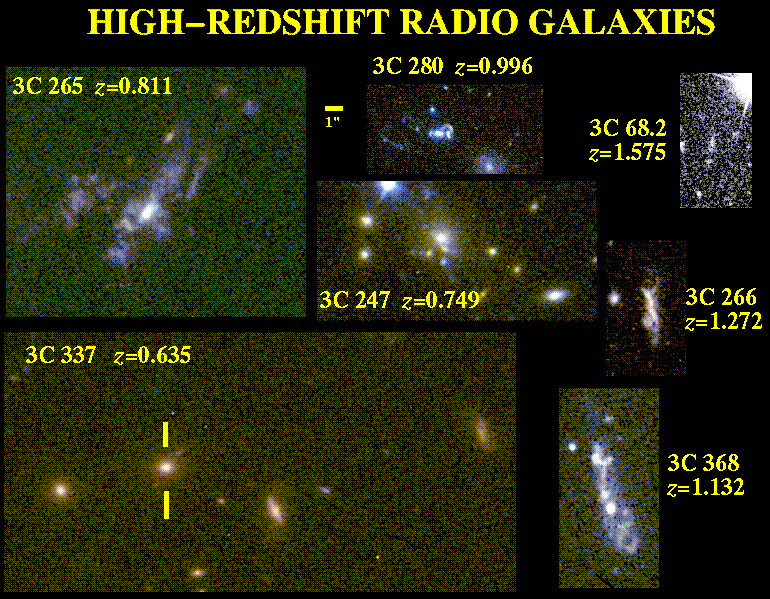
Radio galaxies have been popular tracers of galaxy evolution, because they were long the easiest galaxies to pick out at high redshift - a faint galaxy with an associated radio source is more likely to be an intrinsically luminous galaxy far away than is a similarly faint galaxy without a radio source, most of which will be genuinely small and dim galaxies in the foreground. Indeed, radio galaxies have frequently held the record for highest known galaxy redshift. Detailed examination has shown that many of these high-redshift radio galaxies, seen when the Universe was half of its present age or less, have bizarre structures. They are very elongated, often consisting of chains of distinct clumps. This has led to serious questions about how representative they are of the galaxy population in general - is this appearance due to youth, the powerful radio source, or that fact that we are observing them preferentially in their own ultraviolet range?
This collection compares several radio galaxies from the 3C catalog as imaged with HST. The redshifts range from z=0.635 for 3C 337 to z=1.575 for 3C 68.2. All are shown to the same angular scale (the transformation to linear scale depends heavily on what cosmological model is used). These images are all in the emitted ultraviolet, where seeing any bright structure in a galaxy marks it as unusual either in star formation rate or having a powerful active nucleus. Among these galaxies, the lowest-redshift examples of 3C 247 an d 3C 337 are the most "normal", much like ellipticals in nearby cluster environments, while the higher-redshift objects such as 3C 368 and 3C68.2 are the strangest by our present-epoch standards.
The radio sources all have elongated structures with the brightest parts being twin lobes or "hot spots" of radio emission. It is a remarkable correlation for high-redshift radio galaxies that when the optical galaxy is elongated, it preferentially aligns with the radio source (the "alignment effect"), while there is no such tendency for nearby, lower-power radio galaxies. The radio lobes are just inside the area shown for 3C 247, 3C 266, 3C 280, 3C 337, and 3C 368, and well beyond it for 3C 68.2 and 3C 265.
All these sources are among the brightest radio sources in the sky at low frequencies, having been discovered in the Third Cambridge (3C) survey, revised and completed in 1962. This list was long the richest compilation of powerful and distant radio galaxies, despite being confined to such strong levels of observed radio brightness. These are among the most powerful radio sources in the Universe.
These data were provided by Philip Best and Malcolm Longair, as described in the paper by Best, Longair, and Roettgering, MNRAS 292, 758 (1997). The color images are composites based on images through V-band (5550 Angstroms) and near-infrared I-band (8500 Angstroms) filters plus a synthetic intermediate one, and represent the colors as seen in our observed reference frame. The part of the emitted spectrum we are seeing here ranges from blue (for the lowest redshifts) to ultraviolet at the highest redshifts.